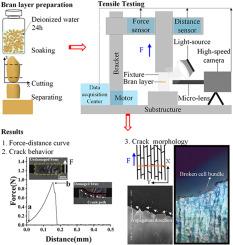The structural-mechanical damage behavior of rice bran layer under tensile processing for moderate milling
Abstract
Bran layer moderate removal during rice milling is a crucial process for reducing rice broken rate and nutrient loss. The bran layer structural-cracking behavior is analyzed using a self-developed in-situ observation tensile tester with high-speed image acquisition. The rice bran tissue microstructure, chemical composition, cracking morphology are in-depth investigated. The results show that rice bran pericarp cells are of reticulate network, cell shape with rectangular or elliptical.significant differences in cell distribution and density across rice varieties, with Japonica rice (NJ5055) with a denser and more uniform structure, exhibiting higher ductility and tensile strength. The rice bran exhibited linear elastic rheological behavior. The bran tensile property is different under tensing directions, the tensile strength shows longitudinal (Y) > radial (X). Cracking along the cell long axis is Y direction, showing orderly line cracking path. Cracking along cell short axis is X direction, showing zigzag cracking path. Pericarp cells geometrical structure determines the mechanical strength and cracking-removal resistance ability of rice bran. The pericarp layer significantly enhances the ductility of the bran layer, allowing it to stretch and deform under stress, thereby improving overall mechanical performance. Rice bran structural-mechanical properties are affected by micro-structure and components.


 求助内容:
求助内容: 应助结果提醒方式:
应助结果提醒方式:


